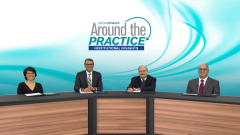
Selecting the Optimal Induction Therapy in Transplant-Eligible Newly Diagnosed Multiple Myeloma
Expert perspectives on the real-world use of induction therapy and transplant in patients with transplant-eligible newly diagnosed multiple myeloma.
Episodes in this series

Transcript:
Alfred Garfall, MD:Thinking about how we would integrate these data into our practice, Ed, could you talk a little about whether transplant makes sense for this patient? What are your thoughts on transplant in general for patients with newly diagnosed multiple myeloma who are eligible based on these data?
Edward Stadtmauer, MD: I’ve lived the history of stem cell transplant for myeloma. For the past 30 years, we’ve been incorporating a slug of high-dose melphalan and autologous stem cell transplant to see if we can deepen the response and prolong the duration of remission. Every time there’s a comparative trial of transplant vs no transplant, the addition of high-dose melphalan seems to prolong the duration of response. We keep asking these questions as we come up with better initial therapies and deeper remissions. So far, every study shows that you have this continued improvement in outcome with melphalan. We’re hopeful that won’t be the case with some of the newer agents.
I feel pretty strongly that patients, regardless of the depth of their response, seem to benefit from the addition as a group. It would be nice if we were able to determine individuals who may or may not benefit from, but the group does seem to benefit. I don’t believe that every patient who goes into remission in initial therapy should get transplanted, but every patient should be considered for transplantation, given that the high-dose melphalan does seem to add things.
This is a patient who started very sick, potentially frail, and had renal insufficiency. I don’t make the decision about how I’m going to consolidate a remission at the diagnosis. I start with the best therapies, which this patient had. Once they’re in remission, I determine if this is appropriate for their disease status and organ function, if this is somebody who may benefit from it.
The randomized DETERMINATION trial makes us comfortable that not every patient needs to get a transplant in first remission to have long-term survival. But we shouldn’t underestimate that a long duration of remission is a beneficial thing. The patients who get it in early remission seem to have early remission.
Alfred Garfall, MD:There’s comparable overall survival, but when you think about duration of first response that you get with potent induction therapy and transplant, there may still be a differentoverall survival that emerges with time. The follow-up on that trial was very long, but when you look at the overall survival we’re seeing with modern therapies, it could take a long time for overall survival differences to emerge.
We talked about the high-risk factors. Dan, you pointed out some of this patient’s high-risk factors at diagnosis. How does that affect your decision on whether to go to transplant or consider transplant, and on the type of induction therapy that you would choose for a patient?
Dan Vogl, MD: When thinking about the transplant decision, the biggest lesson that comes out of the IFM 2009 trial and the DETERMINATION trial is that all the patients had stem cells collected and had the opportunity to get a stem cell transplant in second response, even if they didn’t get it in first response. The main reason we may not see an overall survival benefit from the transplant as part of initial therapy is that it may be just as good to do it as part of second-line therapy. For the individual patient, regardless of whether you’re going to include a stem cell transplant as part of initial therapy or defer it, it’s important to think about collecting stem cells in first response to make sure it’s going to be an option later and to make sure the patients are thinking about it. It’s not so much, “Are they going to get a transplant ever?” but “When would be the optimal time to use this very intensive chemotherapy treatment?” Then individualize the decision to that patient’s particular needs.
I’m not sure if the cytogenetic risk status of the patient at the time of diagnosis should clearly play into that decision. Patients who have higher-risk cytogenetics do worse after a stem cell transplant, but they also do worse after almost any therapy that you could think of. This means you must go back to the principle: do we think the treatment yields benefit? In trial after trial, we’ve seen that high-dose melphalan improves duration of response. Most studies until the modern era clearly showed an improvement in overall survival. We should consider stem cell transplant for all our patients at the time of diagnosis and think about how we’re going to incorporate that into their consolidation regimen.
Alfred Garfall, MD: Thank you.
Transcript edited for clarity.
Newsletter
Stay up to date on recent advances in the multidisciplinary approach to cancer.









